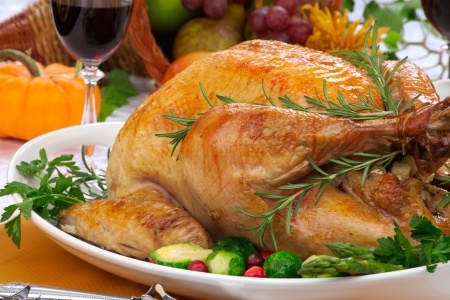 Eating turkey this past Thanksgiving got me thinking about what a delicious nutritional powerhouse turkey actually is. After all, is there any more appropriate time of year to praise the nutritional virtues of turkey? It’s an excellent source of complete protein and also is a lean choice as it has lower fat and saturated fat.
Eating turkey this past Thanksgiving got me thinking about what a delicious nutritional powerhouse turkey actually is. After all, is there any more appropriate time of year to praise the nutritional virtues of turkey? It’s an excellent source of complete protein and also is a lean choice as it has lower fat and saturated fat.
When you choose the white meat over dark, you can save even more calories, fat, and saturated fat. For example, 3 ½ oz. of roasted skinless dark meat turkey has 170 calories, 6 grams of total fat and 2 grams of saturated fat while the same amount of roasted, skinless, light meat has only 130 calories, ½ grams of total fat, and 0 grams of saturated fat. It may be the smartest serving on your whole plate.
Don’t Forget to Give Thanks that Your Turkey is a Nutritional Powerhouse!
Turkey is not only a reasonably priced, lean protein choice, but it also packed with micronutrients. A 3.5 oz. serving of roasted skinless turkey breast provides up to 45% of your daily value (DV) of selenium, 35% DV of niacin, 30% of B6, 20% DV of phosphorus, 10% DV of zinc, and 8% DV of iron. It also provides copper, molybdenum, calcium, magnesium, B12, B5, vitamin D, folate, thiamin, and manganese. It’s kind of like taking a protein-packed multivitamin! Only it tastes better.
So What Do the Major Nutrients in the Turkey You’re Eating Do For You?
Selenium is a trace mineral that is essential to life. It plays a part in your reproductive health, thyroid gland function, DNA synthesis, and your immune system. It also has antioxidant properties that protect your cells and help prevent the oxidative damage that can cause inflammation and/or cell aggregation. Some studies have also shown an inverse relationship between cancer and heart disease and selenium intake, but evidence remains limited and inconclusive.
Niacin and B6, like other B vitamins, help you convert food into energy which can improve your metabolism. Niacin helps many enzymes in your body function normally —including some involved in DNA repair— which also suggests a potential relation to reduced risk of cancer. In pharmacologic doses, niacin can even have blood lipid lowering activity. Vitamin B6 helps to form hemoglobin, the iron-containing, oxygen-carrying component in your blood, and also helps to synthesize immune lymphocytes and other elements of the immune system.
Phosphorus is a mineral that helps to build your bones and teeth. It is also part of just about every energy-producing reaction in your body. It aids in DNA and RNA production, and in turn helps your body with growth and repair.
Zinc is a mineral that plays an essential role in growth, cell repair, wound healing, immune function, DNA synthesis and energy production.
The mineral iron is critical to the structure of hemoglobin and myoglobin, the oxygen-binding proteins that are found in your red blood cells and muscle cells, respectively. In addition to those important functions, iron plays a role in energy metabolism, growth, DNA synthesis, enzymatic reactions, neurotransmitter synthesis, and protein synthesis.
Who Knew this Often-Overshadowed Thanksgiving Staple Did So Much for Your Health?
So don’t hesitate when thinking about whether you should make a meal out of that leftover turkey or not. Letting it go to waste would mean missing out on a nutrient-rich and flavorful holiday treat!
Need some healthier ideas to reinvent your Thanksgiving leftovers? Try looking here:
- New Ways to Use Thanksgiving Leftovers (EatingWell.com)
- Global Recipes for Thanksgiving Leftovers (CookingLight.com)
- Healthy Thanksgiving Leftover Recipes: Ideas from Nutritionists (HuffingtonPost.com)
- 9 Great Recipes for Leftover Turkey (Health.com)
If you are interested in nutrition, see our Nutritional Guide to Whole Grains (it's our area of expertise!):
You may also want to read our previous posts with tips for good nutrition during the holidays:




